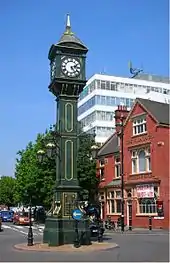Chamberlain Clock
The Chamberlain Clock is an Edwardian, cast-iron, clock tower in the Jewellery Quarter of Birmingham, England. It was erected in 1903 to mark Joseph Chamberlain's tour of South Africa between 26 December 1902 and 25 February 1903, after the end of the Second Boer War. The clock was unveiled during Chamberlain's lifetime, in January 1904[1] by Mary Crowninshield Endicott, Joseph Chamberlain's third wife.[2]

Standing at the junction of Vyse and Frederick Streets with Warstone Lane, it is now a local landmark and symbol of the Quarter.[3] Chamberlain had been a resident on Frederick Street and had also helped jewellers through his campaign work to abolish Plate Duties – a tax affecting jewellery tradesmen of the time.[2] The timepiece was originally powered by a clockwork winding handle. It was later adapted to electricity but fell into disrepair and lost its chime.
It was fully restored in 1989.[1]
On the 22nd August 2020, the Chamberlain Clock was being removed for restoration work by Smith of Derby. It is expected to return in early 2021. [4][5]
References
| Wikimedia Commons has media related to Chamberlain Clock. |
- "Chamberlain Clock". GeoCrawl. Archived from the original on 2014-08-22. Retrieved 2008-09-04.
- "The Chamberlain Clock". The Jewellery Quarter in Birmingham. Archived from the original on 2001-06-29. Retrieved 2008-09-04.
- "Jewellery Quarter Conservation Area - Character Appraisal and Management Plan (Part 2)". Birmingham City Council. 28 January 2002. Archived from the original (pdf) on 10 February 2006. Retrieved 2008-09-02.
- Taylor Rooke (4 August 2020). "The Chamberlain Clock to be removed for extensive repairs". Birmingham Updates. Retrieved 22 August 2020.
- "Jewellery Quarter Chamberlain Clock". Jewellery Quarter BID. Retrieved 22 August 2020.